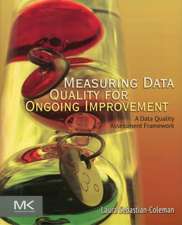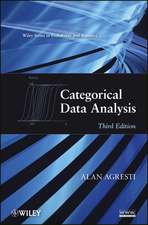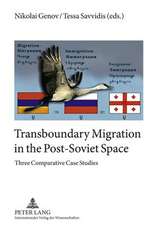An Introduction to Categorical Data Analysis, 3rd Edition: Wiley Series in Probability and Statistics
Autor A Agrestien Limba Engleză Hardback – 21 ian 2019
The use of statistical methods for categorical data has increased dramatically, particularly for applications in the biomedical and social sciences.An Introduction to Categorical Data Analysis, Third Editionsummarizes these methods and shows readers how to use them using software. Readers will find a unified generalized linear models approach that connects logistic regression and loglinear models for discrete data with normal regression for continuous data.
Adding to the value in the new edition is:
Illustrations of the use of R software to perform all the analyses in the book
A new chapter on alternative methods for categorical data, including smoothing and regularization methods (such as the lasso), classification methods such as linear discriminant analysis and classification trees, and cluster analysis
New sections in many chapters introducing the Bayesian approach for the methods of that chapter
More than 70 analyses of data sets to illustrate application of the methods, and about 200 exercises, many containing other data sets
An appendix showing how to use SAS, Stata, and SPSS, and an appendix with short solutions to most odd–numbered exercises
Written in an applied, nontechnical style, this book illustrates the methods using a wide variety of real data, including medical clinical trials, environmental questions, drug use by teenagers, horseshoe crab mating, basketball shooting, correlates of happiness, and much more.
An Introduction to Categorical Data Analysis, Third Editionis an invaluable tool for statisticians and biostatisticians as well as methodologists in the social and behavioral sciences, medicine and public health, marketing, education, and the biological and agricultural sciences.
Din seria Wiley Series in Probability and Statistics
- 24%
 Preț: 709.66 lei
Preț: 709.66 lei - 24%
 Preț: 701.55 lei
Preț: 701.55 lei - 20%
 Preț: 446.47 lei
Preț: 446.47 lei - 23%
 Preț: 986.97 lei
Preț: 986.97 lei - 24%
 Preț: 1001.21 lei
Preț: 1001.21 lei - 20%
 Preț: 512.10 lei
Preț: 512.10 lei - 14%
 Preț: 882.53 lei
Preț: 882.53 lei - 24%
 Preț: 742.26 lei
Preț: 742.26 lei - 24%
 Preț: 678.66 lei
Preț: 678.66 lei - 14%
 Preț: 734.43 lei
Preț: 734.43 lei - 20%
 Preț: 432.39 lei
Preț: 432.39 lei - 24%
 Preț: 831.33 lei
Preț: 831.33 lei - 24%
 Preț: 816.66 lei
Preț: 816.66 lei - 20%
 Preț: 481.53 lei
Preț: 481.53 lei -
 Preț: 313.49 lei
Preț: 313.49 lei - 14%
 Preț: 794.49 lei
Preț: 794.49 lei - 5%
 Preț: 1096.56 lei
Preț: 1096.56 lei - 20%
 Preț: 442.06 lei
Preț: 442.06 lei - 8%
 Preț: 576.80 lei
Preț: 576.80 lei - 24%
 Preț: 571.26 lei
Preț: 571.26 lei - 24%
 Preț: 739.43 lei
Preț: 739.43 lei - 24%
 Preț: 561.57 lei
Preț: 561.57 lei - 24%
 Preț: 840.12 lei
Preț: 840.12 lei - 24%
 Preț: 885.94 lei
Preț: 885.94 lei - 24%
 Preț: 817.10 lei
Preț: 817.10 lei - 9%
 Preț: 1018.55 lei
Preț: 1018.55 lei - 9%
 Preț: 1156.10 lei
Preț: 1156.10 lei - 9%
 Preț: 1084.76 lei
Preț: 1084.76 lei - 9%
 Preț: 959.15 lei
Preț: 959.15 lei - 9%
 Preț: 1049.41 lei
Preț: 1049.41 lei - 9%
 Preț: 1005.45 lei
Preț: 1005.45 lei - 9%
 Preț: 2242.09 lei
Preț: 2242.09 lei - 9%
 Preț: 2900.07 lei
Preț: 2900.07 lei - 9%
 Preț: 1052.38 lei
Preț: 1052.38 lei - 9%
 Preț: 1057.14 lei
Preț: 1057.14 lei - 9%
 Preț: 1703.85 lei
Preț: 1703.85 lei - 9%
 Preț: 1715.64 lei
Preț: 1715.64 lei - 27%
 Preț: 1197.22 lei
Preț: 1197.22 lei - 9%
 Preț: 967.34 lei
Preț: 967.34 lei - 9%
 Preț: 956.95 lei
Preț: 956.95 lei - 9%
 Preț: 961.92 lei
Preț: 961.92 lei - 9%
 Preț: 1148.91 lei
Preț: 1148.91 lei - 9%
 Preț: 1278.54 lei
Preț: 1278.54 lei - 5%
 Preț: 1257.50 lei
Preț: 1257.50 lei - 9%
 Preț: 1271.30 lei
Preț: 1271.30 lei - 9%
 Preț: 950.46 lei
Preț: 950.46 lei - 9%
 Preț: 1051.59 lei
Preț: 1051.59 lei - 9%
 Preț: 1123.83 lei
Preț: 1123.83 lei - 9%
 Preț: 1012.99 lei
Preț: 1012.99 lei
Preț: 779.16 lei
Preț vechi: 1025.22 lei
-24% Nou
149.09€ • 155.66$ • 123.39£
Carte disponibilă
Livrare economică 14-28 martie
Livrare express 27 februarie-05 martie pentru 38.96 lei
Specificații
ISBN-10: 1119405262
Pagini: 400
Dimensiuni: 179 x 262 x 26 mm
Greutate: 0.75 kg
Ediția:3rd Edition
Editura: Wiley
Seria Wiley Series in Probability and Statistics
Locul publicării:Hoboken, United States
Public țintă
Primary: undergraduate courses in categorical data analysis; Secondary: researchers and practitioners in related fields interested in learning methods for applying CDA in their subjects.Descriere
A valuable new edition of a standard reference
The use of statistical methods for categorical data has increased dramatically, particularly for applications in the biomedical and social sciences. An Introduction to Categorical Data Analysis, Third Edition summarizes these methods and shows readers how to use them using software. Readers will find a unified generalized linear models approach that connects logistic regression and loglinear models for discrete data with normal regression for continuous data.
Adding to the value in the new edition is:
Illustrations of the use of R software to perform all the analyses in the book
A new chapter on alternative methods for categorical data, including smoothing and regularization methods (such as the lasso), classification methods such as linear discriminant analysis and classification trees, and cluster analysis
New sections in many chapters introducing the Bayesian approach for the methods of that chapter
More than 70 analyses of data sets to illustrate application of the methods, and about 200 exercises, many containing other data sets
An appendix showing how to use SAS, Stata, and SPSS, and an appendix with short solutions to most odd–numbered exercises
Written in an applied, nontechnical style, this book illustrates the methods using a wide variety of real data, including medical clinical trials, environmental questions, drug use by teenagers, horseshoe crab mating, basketball shooting, correlates of happiness, and much more.
An Introduction to Categorical Data Analysis, Third Edition is an invaluable tool for statisticians and biostatisticians as well as methodologists in the social and behavioral sciences, medicine and public health, marketing, education, and the biological and agricultural sciences.
Textul de pe ultima copertă
A valuable new edition of a standard reference
The use of statistical methods for categorical data has increased dramatically, particularly for applications in the biomedical and social sciences. An Introduction to Categorical Data Analysis, Third Edition summarizes these methods and shows readers how to use them using software. Readers will find a unified generalized linear models approach that connects logistic regression and loglinear models for discrete data with normal regression for continuous data.
Adding to the value in the new edition is:
Illustrations of the use of R software to perform all the analyses in the book
A new chapter on alternative methods for categorical data, including smoothing and regularization methods (such as the lasso), classification methods such as linear discriminant analysis and classification trees, and cluster analysis
New sections in many chapters introducing the Bayesian approach for the methods of that chapter
More than 70 analyses of data sets to illustrate application of the methods, and about 200 exercises, many containing other data sets
An appendix showing how to use SAS, Stata, and SPSS, and an appendix with short solutions to most odd–numbered exercises
Written in an applied, nontechnical style, this book illustrates the methods using a wide variety of real data, including medical clinical trials, environmental questions, drug use by teenagers, horseshoe crab mating, basketball shooting, correlates of happiness, and much more.
An Introduction to Categorical Data Analysis, Third Edition is an invaluable tool for statisticians and biostatisticians as well as methodologists in the social and behavioral sciences, medicine and public health, marketing, education, and the biological and agricultural sciences.
Cuprins
Preface
1. Introduction
1.1 Categorical Response Data
1.2 Probability Distributions for Categorical Data
1.3 Statistical Inference for a Proportion
1.4 Statistical Inference for Discrete Data
1.5 Bayesian Inference for Proportions
1.6 Using R Software for Statistical Inference about Proportions
Exercises
2. Analyzing Contingency Tables
2.1 Probability Structure for Contingency Tables
2.2 Comparing Proportions in 2×2 Contingency Tables
2.3 The Odds Ratio
2.4 Chi–Squared Tests of Independence
2.5 Testing Independence for Ordinal Variables
2.6 Exact Frequentist and Bayesian Inference
2.7 Association in Three–Way Tables
Exercises
3. Generalized Linear Models
3.1 Components of a Generalized Linear Model
3.2 Generalized Linear Models for Binary Data
3.3 Generalized Linear Models for Counts and Rates
3.4 Statistical Inference and Model Checking
3.5 Fitting Generalized Linear Models
Exercises
4. Logistic Regression
4.1 The Logistic Regression Model
4.2 Statistical Inference for Logistic Regression
4.3 Logistic Regression with Categorical Predictors
4.4 Multiple Logistic Regression
4.5 Summarizing Effects in Logistic Regression
4.6 Summarizing Predictive Power: Classification Tables, ROC Curves, and Multiple Correlation
Exercises
5. Building and Applying Binary Regression Models
5.1 Strategies in Model Selection
5.2 Model Checking
5.3 Infinite Estimates in Logistic Regression
5.4 Bayesian Inference, Penalized Likelihood, and Conditional Likelihood for Logistic Regression
5.5 Alternative Link Functions: Linear Probability and Probit Models
5.6 Sample Size and Power for Logistic Regression
Exercises
6. Multicategory Logit Models
6.1 Baseline–Category Logit Models for Nominal Responses
6.2 Cumulative Logit Models for Ordinal Responses
6.3 Cumulative Link Models: Model Checking and Extensions
6.4 Paired–Category Logit Modeling of Ordinal Responses
Exercises
7. Loglinear Models for Contingency Tables and Counts
7.1 Loglinear Models for Counts in Contingency Tables
7.2 Statistical Inference for Loglinear Models
7.3 The Loglinear Logistic Model Connection
7.4 Independence Graphs and Collapsibility
7.5 Modeling Ordinal Associations in Contingency Tables
7.6 Loglinear Modeling of Count Response Variables
Exercises
8. Models for Matched Pairs
8.1 Comparing Dependent Proportions for Binary Matched Pairs
8.2 Marginal Models and Subject–Specific Models for Matched Pairs
8.3 Comparing Proportions for Nominal Matched–Pairs Responses
8.4 Comparing Proportions for Ordinal Matched–Pairs Responses
8.5 Analyzing Rater Agreement
8.6 Bradley Terry Model for Paired Preferences
Exercises
9. Marginal Modeling of Correlated, Clustered Responses
9.1 Marginal Models Versus Subject–Specific Models
9.2 Marginal Modeling: The Generalized Estimating Equations (GEE) Approach
9.3 Marginal Modeling for Clustered Multinomial Responses
9.4 Transitional Modeling, Given the Past
9.5 Dealing with Missing Data
Exercises
10. Random Effects: Generalized Linear Mixed Models
10.1 Random Effects Modeling of Clustered Categorical Data
10.2 Examples: Random Effects Models for Binary Data
10.3 Extensions to Multinomial Responses and Multiple Random Effect Terms
10.4 Multilevel (Hierarchical) Models
10.5 Latent Class Models
Exercises
11. Classification and Smoothing
11.1 Classification: Linear Discriminant Analysis
11.2 Classification: Tree–Based Prediction
11.3 Cluster Analysis for Categorical Responses
11.4 Smoothing: Generalized Additive Models
11.5 Regularization for High–Dimensional Categorical Data (Large p) Exercises
12. A Historical Tour of Categorical Data Analysis Appendix: Software for Categorical Data Analysis
A1: R for Categorical Data Analysis
A2: SAS for Categorical Data Analysis A3: Stata for Categorical Data Analysis A4: SPSS for Categorical Data Analysis
Brief Solutions to Some Odd–Numbered Exercises
Bibliography
Examples Index
Subject Index
Notă biografică
ALAN AGRESTI is Distinguished Professor Emeritus at the University of Florida. He has presented short courses on categorical data methods in 35 countries. He is the author of seven books, including the bestselling Categorical Data Analysis (Wiley), Foundations of Linear and Generalized Linear Models (Wiley), Statistics: The Art and Science of Learning from Data (Pearson), and Statistical Methods for the Social Sciences (Pearson).















